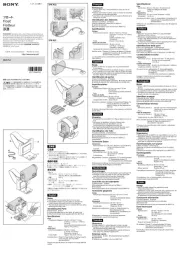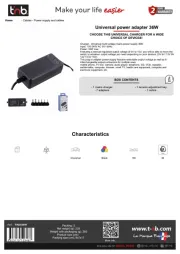SetonixSynth Tidbit Audio Handleiding
SetonixSynth
Niet gecategoriseerd
Tidbit Audio
Bekijk gratis de handleiding van SetonixSynth Tidbit Audio (3 pagina’s), behorend tot de categorie Niet gecategoriseerd. Deze gids werd als nuttig beoordeeld door 8 mensen en kreeg gemiddeld 3.6 sterren uit 4.5 reviews. Heb je een vraag over SetonixSynth Tidbit Audio of wil je andere gebruikers van dit product iets vragen? Stel een vraag
Pagina 1/3

Psychedelic Voltage Processor
Quad LED Chaos User’s Manual - Eurorack
Copyright 2023 SetonixSynth & Tidbit Audio. All rights reserved.

Hello and thank you for using the Psychedelic Voltage Processor for Eurorack, one of the first
collaborative modules from SetonixSynth and Tidbit Audio. We hope you will find its fluctuations most
pleasing!
The Psychedelic Voltage Processor, or PVP, is a four-channel chaos module. It uses color-changing LEDs
to produce fluctuating voltages in response to the Channel input, with each channel normalized in series
to create increasingly chaotic “taps” that can be used one after another for different variations.
Any positive voltage input such as unipolar LFOs, envelopes, stepped voltages, or simply the onboard
normalized voltage patched to a channel input is reproduced approximately on each channel output, with
the PVP inducing unpredictable fluctuations due to the variable current consumed by an LED circuit with a
mind of its own.
Technical Specifications (Eurorack standard)
Width: 8hp
Depth: 25mm
Peak Current Draw: 135mA @ +12V, 10mA @ -12V
Input Impedance (Channel 1): 150kΩ
Input Impedance (Channels 2-4): 100kΩ
Output Impedance (All Channels): 1kΩ, DC Coupled
1. Connecting your Psychedelic Voltage Processor
Before using the PVP, take extra note of the Peak Current Draw spec above. This module’s current draw
from the +12V rail depends largely upon the brightness of the LEDs and is continuously variable, but will
reach 120-135 mA on occasion. As such, it’s a good idea to double check that your Eurorack power
supply has at least this much current to spare at all times, or ideally a larger amount such as 250mA to
spare.
Connect a 10-to-16 pin ribbon power cable to the header at the top of the Psychedelic Voltage Processor
pcb. The -12V/red stripe side of the connector must be aligned with white stripe silkscreen indicator
labeled “-12V” for proper use. If your PVP has a shrouded power header, this will prevent you from
plugging it in the wrong way, so do not modify it. This module is reverse voltage protected, but it is still not
recommended that you plug it in backwards to see what happens.
2. Theory of Operation
The PVP began life as an active adaptation of the Tidbit Audio Random CV Processor. It uses similar
LEDs to those found in the Random CV Tidbit to create a chaotically fluctuating voltage signal that is
related to the input voltage, but utilizes the Eurorack format to expand on this circuit’s ability to provide
chaos and also create a visually-pleasing “window” with the panel of the module for viewing the workings
of the module. With this design, we hope to retain the original Tidbit’s minimalist appeal while also
creating something new and uniquely useful.
The Input/Output routing scheme of the PVP is designed to encourage messing around and happy
accidents, but there are just a few things to keep in mind while patching:
- The PVP responds to and processes positive input voltages only; negative voltage inputs are
ignored. It will also not output any voltage below 0V, and will act as a “half wave rectifier” on any

signal that would otherwise drop below this level. For example, a +/-5V input signal will be
processed into an approximately 0-5V “chaotic” output with the waveform’s bottom half “clipped”
at 0V. Most audio signals in Eurorack are centered around 0V, so if fed into the PVP without any
additional offset the signal’s bottom half will be clipped. (Note: this sounds cool!)
- The input of each Channel is normalized to the prior channel’s output (except Channel 1’s input,
see below). If a signal is patched to a Channel input, the normalization from the prior channel will
be broken and the Channel in question will process the input signal only.
- The Upper Knob is a simple unipolar attenuator for Channel 1’s input normalized to a static
voltage. If anything is patched to the input of Channel 1, the knob will act as an attenuator for this
signal. If anything is patched into the inputs of Channel 2 onwards, the normalization from
Channel 1’s output is broken and the knob will have no further influence over other channels.
3. Summary of Functions
Front Panel: LED circuit visualizers. Each Channel’s LEDs “steal” current from one another to create an
unpredictable chaotic voltage which the PVP utilizes for your patching pleasure.
Upper Knob: Input signal level attenuator for Channel 1. With nothing patched to the Channel 1 input, a
10V static voltage is normalized to the input and the Upper Knob thus controls the level of the voltage
sent to Channel 1, from 0-10V. Patching a cable to Channel 1’s input will interrupt the normalized voltage
and the Upper Knob becomes an attenuator, with the input signal to Channel 1 “muted” when fully CCW
and at Unity Gain when fully clockwise.
Channel 1 Input: The module’s “Master” CV input in a sense. Any signal patched to this input will be
attenuated by the Upper Knob before being processed by Channel 1 along with any other Channels for
which normalization is maintained.
Channel 2-4 Inputs: Non-attenuated direct CV inputs for each LED processor Channel. A signal patched
to one of these Inputs will interrupt the normalization from the preceding Output and be processed directly
by the corresponding channel. With nothing patched, these Inputs receive their signal from the previous
Channel Output, and using more Channels in a row to process a signal will lead to a more chaotic output.
Channel Outputs: Signal outputs for each of the four processor Channels. Positive input voltages fed to
the corresponding Channel input are processed chaotically and reproduced on the output, which will
generate an unpredictable, fluctuating output voltage that somewhat tracks the input between 0V and 10V
but will deviate in either direction. An input of Ground/0V generally causes low-level chaotic fluctuations
near 0V on the Channel output, while negative voltage inputs will lead to an output of 0V that does not
fluctuate much, if at all.
5. Calibration
Calibration of the PVP is easiest with an oscilloscope, but can be accomplished with a Multimeter as well.
- Patch a unipolar (aka, positive voltage only) low-frequency variable CV source such as a looping
envelope or slope generator (ideally 0-10V but 0-5V or 0-8V will work too) to the Channel 1 Input..
Use your oscilloscope to monitor the voltage range of the input, or make a note of the range if
using a multimeter.
- Turn the Upper Knob fully clockwise and monitor the first Channel Output. Adjust the top rear
trimmer so that the range of the Channel Output roughly tracks the voltage of the input, with the
output neither spending too much time at exactly 0V nor going more than about 500mV above the
original input level. (Note there will be variations between cycles as it is a chaotic module.)
- When you are satisfied, patch the same input signal to the Channel 2 Input and monitor that
Channel output. Repeat the prior rear trimmer adjustment directions, but for the second trimmer.
- Repeat this process for Channels 2, 3 and 4.
Product specificaties
| Merk: | SetonixSynth |
| Categorie: | Niet gecategoriseerd |
| Model: | Tidbit Audio |
Heb je hulp nodig?
Als je hulp nodig hebt met SetonixSynth Tidbit Audio stel dan hieronder een vraag en andere gebruikers zullen je antwoorden
Handleiding Niet gecategoriseerd SetonixSynth

3 Maart 2025

3 Maart 2025

3 Maart 2025

8 Juli 2023

5 Juli 2023

4 Juli 2023

2 Juli 2023

30 Juni 2023

25 Juni 2023

24 Juni 2023
Handleiding Niet gecategoriseerd
- Celestron
- American International
- Stiebel Eltron
- Beam Electronics
- Magma
- Gossen
- Waterdrop
- Riccar
- MGL Avionics
- Maginon
- Sesame Street
- MSolutions
- Arebos
- FeinTech
- Intermec
Nieuwste handleidingen voor Niet gecategoriseerd

16 September 2025

16 September 2025

16 September 2025

16 September 2025

16 September 2025

16 September 2025

16 September 2025

16 September 2025

16 September 2025

16 September 2025